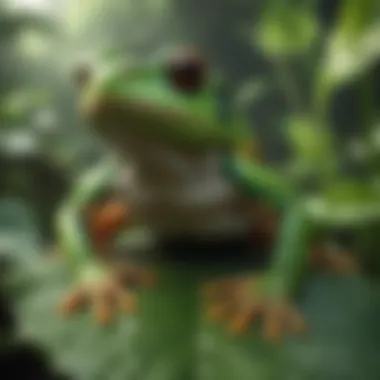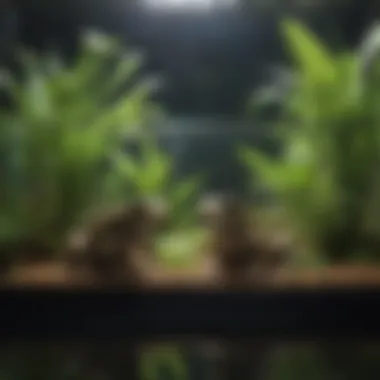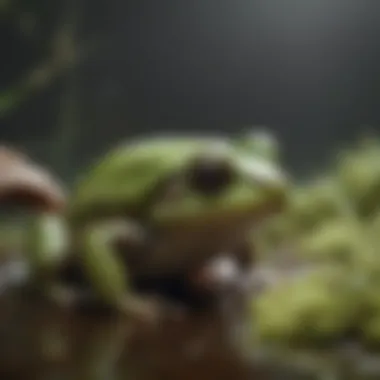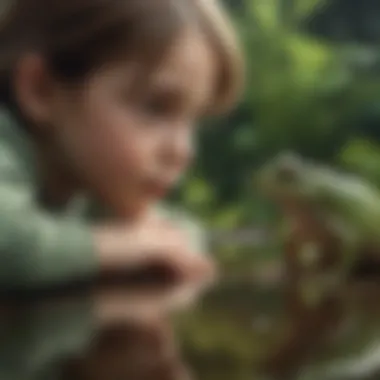Comprehensive Guide to Caring for Pet Frogs at Petsmart


Intro
Frogs can charm anyone with their unique looks and playful hops. But before diving in and bringing one home, it's worth knowing a few things about pet frogs you might find at Petsmart. In this guide, we dissect everything from the various species available to how you can care for them correctly. After all, it’s not just about adopting a pet; it’s about truly understanding and meeting the needs of a living creature.
Pet Care Essentials
Caring for a pet frog is no small feat. These little amphibians require careful attention to their environment, diet, and overall well-being. Here’s where we dive into the essentials of frog care, ensuring your green friend has everything it needs to thrive.
Daily Nutrition Requirements
When it comes to what your frog eats, it's all about variety. Frogs at Petsmart may include species such as African Clawed Frogs or Red-Eyed Tree Frogs. Each requires a tailored diet. Live food such as crickets and mealworms should be part of the menu for most frogs. It's beneficial to supplement this with high-quality frog pellets. Remember, overfeeding can lead to obesity, which is a serious issue in frogs—so heed your pet's comfort and appetite levels.
Exercise and Playtime
While frogs don't need a treadmill, they still appreciate a bit of freedom in their space. Designing an engaging habitat with plenty of climbing spots and hiding places can encourage natural behaviors. Water sources where they can swim and explore also contribute to physical activity.
Grooming Tips
Regular cleaning of their environment is crucial to preventing disease. While frogs don’t require baths in the same way dogs do, keeping their habitat clean can help them stay healthy. Use dechlorinated water when doing maintenance, and always change it out regularly to avoid stagnation.
Health and Wellness Check-ins
Just like humans, frogs can get sick. A simple weekly check to monitor their health can be a lifesaver. Look for signs of lethargy, loss of appetite, or unusual skin changes. Early detection can help prevent serious health issues down the line.
Behavior & Training
Understanding your frog’s behavior can deepen your bond and ensure they’re happy in their environment. Frogs may not respond to training like dogs or cats, but they have their own set of body language and needs.
Understanding Your Pet's Body Language
Frogs have their own quirks. For instance, if a frog is hiding away, it might be feeling stressed. An active frog, on the other hand, is typically a happy one. Learning to interpret these behaviors helps you create a more suitable habitat for them.
Basic Training Techniques
Once you understand their moods, you can work on some basic interactions. Frogs can recognize feeding times. Keeping a consistent routine can ease their anxiety, making them more comfortable in their space.
Behavioral Concerns & Solutions
If your frog isn’t eating or becoming overly aggressive towards tank mates, it’s usually a sign of dissatisfaction in their environment. Adjust elements like temperature, humidity, or space to alleviate these issues.
Socialization Tips
Frogs can be social creatures, but it’s vital to ensure compatibility if you house more than one. Different species might not get along, so pairing compatible types will make for a healthier habitat.
Pet Home Environment
Setting up the right home for your frog can make all the difference. It’s not just about aesthetics; it needs to serve functional purposes for their comfort and health.
Creating a Pet-friendly Space
A spacious terrarium mimics their natural habitat, providing both land and water environments. Ensure to include items like logs and plants for climbing and hiding.
Safety Measures and Hazards to Avoid
Be aware of household items that can be harmful, like certain cleaning products or plants that might be toxic to frogs. Always opt for natural cleaning methods to keep their home safe.
Choosing the Right Toys and Accessories
Frogs generally don’t require toys, as other pets do, but adding rocks and water features can encourage exploration and fitness. Always ensure that any decor is safe and provides enrichment.
Setting Up a Comfortable Resting Area
You can't forget the resting spots! Frogs need a place to unwind and hide securely. Create cozy corners using soft moss or places to burrow for that extra touch of comfort.
Pet Health Issues
A well-cared-for frog can still face health challenges, but understanding common issues can make all the difference in their care.
Recognizing Signs of Illness
Symptoms such as bloating, discoloration, or unusual skin patterns should raise red flags. Observe your pet regularly to catch these changes early.
Preventative Care Measures


Maintain proper habitat parameters with ideal temperature and humidity levels. Regularly change the water and clean tanks to keep diseases at bay.
Common Ailments and Treatments
Some popular ailments include skin infections or parasites. Treatment options vary, but over-the-counter remedies designed specifically for frogs can often be effective. A vet familiar with amphibians is the best resource in more serious cases.
Emergency Preparedness
Know who you’d call in an emergency. Have a plan for medical emergencies, including a vet who specializes in exotic pets. Being prepared can dramatically reduce stress during unexpected situations.
Remember, owning a pet frog is both a joy and a responsibility. Proper care, attention to their needs, and a commitment to learning can lead to a rewarding experience.
Prelims to Pet Frogs
When thinking about pets, most will gravitate towards cats or dogs. However, pet frogs are becoming increasingly popular among animal lovers. Understanding pet frogs is not just a box to tick for the enthusiasts; it's a doorway into an enchanting world rife with unique characteristics and behaviors. This section aims to shed light on the importance of pet frogs as companions, explore their physiological and behavioral traits, and give potential owners a reason or two to consider these amphibians.
Frogs are fascinating creatures, and hosting one in your home can be a rewarding experience. Unlike traditional pets, frogs offer a different dynamic, a charm that is hard to put into words. Their mesmerizing movements, captivating vocalizations and the serene ambiance they provide is unlike anything else. With proper care, they can thrive in a home setting, illuminating daily routines with a touch of the wild.
Considering a frog entails not only thinking about the pet’s environment but also understanding the responsibilities that come with it. Every amphibian has its own requirements—be it dietary needs, habitat specifications, or behavioral traits. By delving deep into these aspects, potential owners can make informed decisions, ensuring that both the pet and owner enjoy a harmonious living experience:
"Owning a frog is a commitment, but it opens a door to an impressive realm of care and connection."
Ultimately, a well-informed buyer will swim through the waters of amphibian care with flying colors. Armed with knowledge about various species, their specific needs, and the general care they require, a new owner can develop a thriving ecosystem that benefits the frog, making it a successful endeavor. Let's dive even further into why considering a frog as a pet can be a unique whirlpool of delight.
Why Consider a Frog as a Pet?
In considering a frog, one finds a plethora of reasons that stand out. First off, they are generally low-maintenance when compared to furry companions. Frogs do not demand the same level of interaction as dogs or cats. This allows for a great deal of flexibility, especially for people with busy schedules or limited space.
Additionally, frogs require less grooming and don’t shed fur, making them ideal for those with allergies. They also present an opportunity to observe exceptionally interesting behaviors that are not prevalent in more traditional pets. Witnessing nocturnal activities can be surprisingly mesmerizing, adding layers of interest to an evening without needing to go far from home.
Moreover, frogs can teach responsibility in unique ways. Caring for such creatures involves regular maintenance of their habitat, precise feeding schedules, and ensuring overall health. This commitment is a good lesson for children and adults alike, demonstrating life skills that extend beyond just caring for their pet.
Understanding Frog Species Available at Petsmart
One of the great things about Petsmart is the wide variety of frog species available. Each type has its own quirks and personality, making it important to familiarize oneself with them before stepping into ownership. Popular species like the American Green Tree Frog and the African Clawed Frog are often found there, each boasting distinct lifestyles and preferences.
When making your selection, consider the following:
- Adaptability: How well does the frog adapt to new environments?
- Lifespan: Different species have varying lifespans, which affects long-term care.
- Habitat Needs: What specific requirements does each species have, such as humidity levels and tank size?
Doing your homework on these traits can enhance your bonding experience with your frog while ensuring their well-being. Each species contributes something special to the pet universe. Ultimately, recognizing your own lifestyle can help narrow down the most suitable amphibian for your future home.
Species Overview
When it comes to choosing a pet frog, understanding the various species available plays a vital role. In the world of amphibians, each species comes with its own set of characteristics, care requirements, and unique behaviors. Getting a grasp on these differences not only enhances the pet owner's experience but also ensures the animal's well-being. This guide aims to make that journey smoother by giving clarity to the common species you'll encounter at Petsmart.
Common Species at Petsmart
American Green Tree Frog
The American Green Tree Frog is one of the most sought-after pet frogs for good reason. Its vibrant green skin isn’t just a treat for the eyes; it’s a testament to its adaptability in various habitats. One significant aspect of this species is its call, which many enthusiasts often describe as one of the most beautiful sounds in the amphibian world. This species can be a friendly companion, especially for those who enjoy observing lively behavior in their pets.
A unique feature of the American Green Tree Frog is its ability to change color slightly, particularly during the night. Owners will find that these frogs are fairly sociable and can be quite active, particularly during the evening hours. On the flip side, they require a specific humidity level and temperature to thrive, which can be a challenge for inexperienced owners. It’s important for potential owners to prepare a suitable environment reflecting their natural habitat.
Poison Dart Frog
If you’re looking for a small but stunning addition to your pet collection, the Poison Dart Frog may catch your eye. These little frogs are famous for their bright colors, which range from vibrant yellows to striking blues. Though they come with an air of caution, their toxic skin can be a fascinating aspect for the right pet owner. It's important to remember that these toxins do not pose a threat if you're properly handling the frog, as they typically lose this trait in captivity.
What sets the Poison Dart Frog apart is its diverse range of colors, which can make any terrarium visually captivating. However, their delicate nature means they demand a highly controlled environment. Unquestionably, this species is ideal for experienced amphibian keepers who know the ropes. Without the right understanding of their needs, owning one can quickly become a daunting task.
African Clawed Frog
For those with a passion for unique and engaging pets, the African Clawed Frog is hard to overlook. Known for their nocturnal feeding habits, these creatures are very distinctive due to their powerful limbs that are perfect for swimming. This species often ends up being a hit among families with children since they are hardy and relatively easy to care for, leading to a lower barrier to entry for new pet owners.
Unique to this frog is the lack of visible eyelids. Instead, they have a clear membrane covering their eyes, giving them a somewhat alien appearance. This adaptation complements their aquatic lifestyle, as they spend a significant amount of time in water, necessitating an environment that mimics their natural habitat. However, it is worth noting that they are not particularly interactive, which might leave some pet owners wishing for a more engaging pet experience.
Characteristics of Each Species
The differences between these frog species extend beyond aesthetics. Understanding their behavior, physical needs, and interaction levels is essential for making an informed choice about which type of frog aligns with your lifestyle and capacity for care.
Each species offers unique rewards and challenges, making it all the more important to do appropriate research before diving in.
Habitat Setup


Creating a suitable habitat for your pet frog is like building their very own paradise. Frogs have particular needs that must be met to ensure they live a happy and healthy life. The right habitat setup not only mimics their natural environment but also contributes greatly to their overall wellbeing. In this section, we'll delve into the nitty-gritty of choosing the right tank, essential features, and other decorative aspects that can enhance your frog's habitat.
Choosing the Right Tank
Choosing the right tank is paramount when it comes to keeping frogs. Think of the tank as your frog’s apartment; it should be spacious and comfortable. Generally, when selecting a tank, consider how big the adult frog will grow.
Size Considerations
The size of the tank plays a crucial role in providing comfort and a sense of security for your pet. A popular option for many frog species is a 20-gallon tank or larger. A larger tank reduces stress and allows for the swimming and hopping room that frogs need to thrive. Additionally, having sufficient space prevents territorial disputes among multiple frogs.
However, a too-big tank can be counterproductive. Frogs might struggle to find their food, and smaller tanks can sometimes make cleaning more manageable. Balance is key.
Material Options
When discussing tank material, glass and acrylic are two top choices. Glass tanks are sturdy, easy to clean, and typically less prone to scratching. They're often preferred for their durability. On the flip side, they can be heavy and a bit of a pain to move around if you need to relocate them.
Acrylic tanks, on the other hand, are lighter and provide great insulation. However, they can scratch easier than glass, so take care during cleaning. Plus, they tend to be more costly, so it might stretch some budgets. Evaluating these characteristics can lead you to decide which tank best fits your situation.
Essential Tank Features
Once you've settled on the type and size of the tank, it’s time to think about its features. Frogs require a specific set of conditions to feel at home, and moisture plays a vital role here.
Frogs' Need for Moisture
Moisture is non-negotiable in a frog's habitat. Frogs breathe through their skin, so they need a humid environment to thrive. An optimal range of humidity is between 60% and 80%. You can achieve this by misting the tank regularly or using a hygrometer to monitor the humidity levels.
Providing a water source is also essential. The water should be clean and dechlorinated to cater to their needs. A small water dish or a section of the tank filled with water is often recommended.
Substrate Selection
The choice of substrate can greatly influence both the tank environment and your frog’s overall health. Organic soils, coconut coir, or sphagnum moss are all excellent options. These substrates retain moisture while also allowing for drainage, which is crucial to prevent mold and foul odors.
Alternatively, certain types of gravel can be used, but they might not be as effective in maintaining moisture levels. Choosing a substrate that enables frogs to burrow and feel secure can also reduce stress.
Decoration and Enrichment
Now that you’ve got the basics covered, it’s time to spruce up the inside of your frog’s home. The right decorations and enrichment not only make the habitat aesthetically pleasing but are also key to your frog’s mental and physical stimulation. Forts from rocks, plants, and even branches can replicate the natural environment frogs are used to. Live plants, in particular, can help maintain humidity levels and provide hiding spots that make frogs feel secure.
In summary, establishing the right habitat setup is fundamental to successful frog ownership. It’s about more than just aesthetics; it’s about creating a thriving ecosystem for your amphibian companion. By understanding the needs surrounding habitat, you can provide an environment that promotes health and happiness for your pet frog.
Dietary Needs
Understanding the dietary needs of pet frogs is crucial for their overall health and well-being. These amphibians have specific nutritional requirements that vary across species, making it essential for frog owners to educate themselves about what to feed their pets. Proper diet not only influences growth and vitality but also plays a significant role in preventing common health problems. In this section, we'll explore the various types of food suitable for frogs, how frequently they should be fed, and the nutritional components essential for their development.
Understanding Frog Diets
Types of Food for Frogs
Frogs are predominantly insectivores, meaning the bulk of their diet is made up of insects. However, some species may also enjoy plant material or commercial frog food. Common food types include:
- Live Insects: Crickets, mealworms, and fruit flies are favorites. They are healthy and mimic the frogs' natural hunting habits.
- Frozen or Freeze-Dried Options: These can be more convenient and still pack a nutritional punch. Look for brands that maintain the quality of the original food.
- Commercial Pellets: Specially formulated frog pellets can also be a good choice, as they provide a balanced diet. Brands such as ReptoMin and Zoo Med have options that cater to different frog species.
These types of food contribute not only to the physical health of the frog but also to its happiness. Live prey can stimulate instinctual hunting behaviors that keep frogs active and engaged in their environment. On the downside, some frog owners might find obtaining live insects to be a bit of a chore, which is where the frozen or pellet options shine. They offer an alternative that's both time-saving and nutritious, although they may not replicate the excitement of a live meal.
Feeding Frequency
The frequency of feedings can vary based on the frog's age and species, but generally, juvenile frogs should be fed daily while adults may do well with every other day feeding. This distinction reflects that younger frogs are growing rapidly and require more nutrient intake.
- Juveniles (up to 3-6 months): Typically need to eat once a day.
- Adults: Often comfortable with being fed every 48 hours.
Adapting to the life cycle is important here. For instance, overfeeding can lead to obesity and health issues; recognizing the appropriate serving size is essential. To avoid mistakes, consider keeping an eye on how your frogs react after meals. If they seem lethargic or uninterested in food, it might be time to reassess your feeding strategy.
Nutritional Requirements
Frogs need a balanced diet that covers proteins, fats, vitamins, and minerals. These components play crucial roles in maintaining health and vitality. Particularly, it's important to include calcium and vitamin D3 in their diet.
- Calcium: Essential for bone health, calcium supplementation through dusting food or providing cuttlebone can prevent metabolic bone disease, a common ailment in pet frogs.
- Vitamin D3: Often linked with calcium absorption, ensuring frogs receive enough vitamin D3 is vital, especially for species with less access to sunlight.
In summary, the dietary needs of your frog are foundational to its long-term health. Not only do you have to choose the right types of food, but also pay attention to how often you provide them and ensure they meet the necessary nutritional requirements.
Behavior and Handling
Understanding the behavior and handling of pet frogs is essential for their well-being and for creating a harmonious environment. Frogs possess unique instincts and behavioral traits. These characteristics can heavily influence how we care for them. Knowing these specifics ensures that we meet their needs adequately, making for a healthier pet and an enjoyable pet ownership experience.


Understanding Frog Behavior
Natural Instincts
One of the most fascinating aspects of frogs is their natural instincts. Frogs are primarily nocturnal creatures, often most active during the twilight hours. This behavior can be traced back to their evolutionary adaptations. It's important to recognize that the natural instincts of frogs influence their need for specific habitat conditions. For instance, most frogs thrive in humid environments, reflecting their natural habitat.
- Key characteristics:
- Benefits: Properly simulating these instincts in a pet owner’s setup encourages natural behaviors, such as hunting and hiding.
- Considerations: If the habitat doesn’t align with their natural instincts, it could lead to stress, which might affect their health. Understanding these instincts helps owners create a suitable environment, ensuring that their pets remain healthy and active.
- Frogs seek shelter during the day, often hiding among plants or in leaf litter.
- Being moisture-loving, they will dehydrate quickly if not provided a suitable environment.
Social Behavior
Frogs aren't typically social organisms, but their social behavior is quite intriguing. Most species tend to be solitary, although some frogs display social tendencies during mating seasons or while in larger groups. This aspect significantly influences their handling and interactions.
- Key characteristics:
- Benefits: Recognizing when frogs interact, such as during mating or communal basking, can inform owners on how to set up housing effectively.
- Considerations: While most frogs can cohabit peacefully, certain species may be territorial, necessitating careful consideration of tank mates.
- Male frogs often engage in vocalizations to attract females, which is an instinctual behavior rooted in reproduction.
- During warm seasons, several frogs might be found in the same area, usually not aggressive towards each other.
Safe Handling Practices
When it comes to handling frogs, keeping their well-being front and center is critical. Frogs are sensitive beings, so owners need to be gentle and aware of their needs. Here are some pointers:
- Always wash your hands before and after handling to avoid spreading oils or contaminants.
- Using wet hands is advisable to reduce skin absorption. Frogs have delicate skin that easily absorbs anything on their surface.
- When lifting a frog, use two hands, supporting its body from beneath. This approach minimizes stress and avoids injury.
Remember, treating these small creatures with care enhances their trust and allows them to thrive in their environments.
Following these guidelines will help build a positive relationship with pet frogs and ensure they maintain good health. Understanding their behavior and practicing safe handling is not merely about pet care; it builds a bond of respect between owner and pet.
Health and Wellness
Taking care of a pet frog is not just about having fancy decorations and a stylish tank; it's all about their health and wellness. Frogs can be delicate creatures, and understanding their needs goes a long way in fostering a thriving environment. Healthy frogs can be more active and display more natural behaviors. Thus, recognizing the importance of their health bestows a sense of responsible ownership to any budding amphibian enthusiast.
Common Health Issues
Signs of Illness
Frogs don’t come with a manual about their ailments, but knowing the signs can save a frog’s life. One key characteristic of a healthy frog is vibrant color and clear skin. If you notice dull colors or the presence of spots, it might point towards an underlying health issue. Frogs often show signs like lethargy, abnormal swimming, or even refusal to eat. Having the eyes bulging or cloudy could also signal trouble.
These signs are beneficial for establishing a preventive mindset. The unique feature about monitoring these symptoms is that they can often lead to early detection of potential problems, which means less stress and expenditure later on. Thus, keeping a vigilant eye can help ensure your pet froggies live a long and healthy life.
Prevention Tips
Preventing health issues is always better than playing catch-up. One of the most effective prevention tips is maintaining a clean habitat. Regularly changing the water and cleaning the tank helps nip potential waterborne illnesses in the bud. A balanced diet that includes live insects will suit most frogs, ensuring they get the right nutrients. The key to prevention is being proactive rather than reactive.
Every pet owner should prioritize their frog's environment as this is crucial to avoiding diseases. The unique feature of these tips lies in their simplicity; small changes can have a massive impact. Keeping a close check on their living conditions can keep the threats at bay effectively.
Veterinary Care for Frogs
Finding a vet who understands exotic pets, particularly amphibians, can be a tedious task. However, ensure that your pet frog gets the right veterinary care when needed. Regular check-ups are not just for other pets but should include your frog too. This might involve fecal examinations to check for parasites or regular skin checks to detect fungal or bacterial infections. The unique aspect of veterinary care for frogs is that it's specialized and may vary drastically from conventional pets like cats and dogs.
Creating a relationship with an exotic pet vet will not only help to keep your frog healthy but can also provide a sense of reassurance to any new owner.
"Health is not just the absence of illness, it's about thriving in one's environment."
Taking steps to ensure the wellness of your pet frog is a reflection of responsible ownership. Understanding their health needs can make all the difference, not only in terms of longevity but also in terms of the joy and satisfaction of having a healthy companion.
The End: Responsible Ownership
Owning a pet frog is not simply a whimsical decision; it’s a commitment that requires understanding the nuances of these unique creatures. Many potential pet owners may be drawn in by the mere aesthetics of frogs, with their vibrant colors and intriguing behaviors, but the truth is far more layered. Recognizing the significance of responsible ownership enables enthusiasts to build a proper habitat and cater to the specific needs of their amphibious companions.
The Commitment to Care
Caring for a frog demands more than occasional feeding and tank maintenance. These creatures thrive in environments tailored to their needs. For instance, a leap away from dry and barren conditions is essential—keeping the humidity levels adequate is a must. This means investing time in researching proper tank setups and ensuring temperature controls are in place.
Furthermore, understanding dietary requirements can't be overlooked. Frogs have diverse nutritional needs depending on their species. Some are insectivores, needing live feeder insects, while others may require specialized pelleted diets. Regularly consulting reputable sources helps ensure you're meeting these dietary demands appropriately.
Additionally, the need for routine checkups cannot be stressed enough. Frogs can be susceptible to various health issues, and being proactive about their health dramatically increases their chances of leading a long and healthy life. Neglect or ignorance can lead to preventable illness. If you notice any signs of distress, such as lethargy, loss of appetite, or unusual behavior, a visit to a vet familiar with exotic pets should be prioritized.
Ultimately, the commitment to care translates into creating a thriving ecosystem that not only supports but celebrates the life of your frog.
Resources for New Owners
Embarking on the adventure of frog ownership requires knowledge and support in abundance. Thankfully, resources abound, a few of which can steer you right:
- Books on Amphibian Care: Titles like "The Book of Frogs" can provide a wealth of knowledge tailored to beginners.
- Online Communities: Platforms like reddit.com host numerous forums where seasoned frog owners share their insights and experiences. Connecting with others who have walked the path can be invaluable.
- Veterinary Services: Seek out vets specializing in reptiles and amphibians. They possess the expertise to address common health concerns specific to frogs.
- Reputable Websites: Websites such as en.wikipedia.org and britannica.com offer foundational information that can cut through the noise and provide factual insights about pet frogs.
"A pet is a responsibility, not a possession."
This sentiment rings fierce and true, especially when it comes to pet frogs. Engaging with the right resources establishes a firm groundwork for responsible pet ownership. Embracing this journey may at times be challenging, but with dedication, the rewards of nurturing a pet frog are immeasurable. Let's champion the cause of responsible ownership, allowing both humans and frogs to flourish in harmony.







